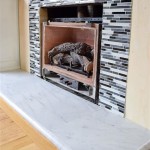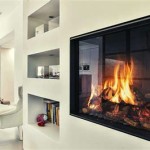Understanding Free-Standing Ventless Propane Fireplaces
Free-standing ventless propane fireplaces offer a convenient and aesthetically pleasing heating solution for homes. Unlike traditional fireplaces, these appliances do not require a chimney or venting system, allowing for flexible placement within a living space. This article will delve into the key aspects of free-standing ventless propane fireplaces, encompassing their operation, advantages, safety considerations, and installation requirements.
Key Point 1: Operational Mechanics and Fuel Efficiency
Free-standing ventless propane fireplaces operate by burning propane gas to generate heat. The core component is a burner system designed for complete combustion. Manufacturers aim for a high level of efficiency, ensuring minimal carbon monoxide production. The units are typically equipped with oxygen depletion sensors (ODS) that automatically shut off the gas supply if oxygen levels in the room become dangerously low. This is a crucial safety feature integral to ventless technology.
Fuel efficiency is a significant advantage of ventless propane fireplaces. The absence of a chimney means that virtually all the generated heat is radiated directly into the room, minimizing heat loss. This contrasts sharply with vented fireplaces, where a substantial portion of the heat escapes through the chimney. Consequently, ventless models can provide comparable heating performance with lower fuel consumption.
The heat output of a free-standing ventless propane fireplace is measured in British Thermal Units (BTUs). These units typically range from 10,000 to 40,000 BTUs, enabling homeowners to select a model appropriate for the size of the room they intend to heat. Accurate BTU selection is important to prevent overheating or inefficient heating.
Controls for ventless propane fireplaces typically include a thermostat to regulate the room temperature. Users can set a desired temperature, and the fireplace will automatically adjust the gas flow to maintain that level. Some advanced models offer remote control functionality, programmable timers, and other automated features.
The source of propane is another key consideration. Free-standing ventless propane fireplaces can be connected to a large external propane tank or use smaller, refillable propane cylinders. The choice depends on usage patterns, space constraints, and aesthetic preferences. Using an external tank requires professional installation of a gas line.
Key Point 2: Advantages and Considerations for Home Heating
The primary advantage of a free-standing ventless propane fireplace is its installation flexibility. Without the need for a chimney, these fireplaces can be placed in virtually any room of the house that has adequate ventilation according to the manufacturer's instructions and local codes. This versatility makes them ideal for homes without existing fireplaces or for adding supplemental heating to specific areas.
Another significant benefit is their cost-effectiveness compared to traditional fireplaces. The absence of chimney construction or modifications significantly reduces installation expenses. Furthermore, the high fuel efficiency translates to lower operating costs over the long term, especially when compared to electric space heaters, which can consume considerable amounts of electricity.
Aesthetic appeal is also a key factor. Free-standing ventless propane fireplaces are available in a wide variety of styles and finishes, allowing homeowners to choose a model that complements their existing decor. Many models feature realistic-looking flame effects and simulated logs, creating a cozy and inviting atmosphere.
However, there are crucial considerations regarding indoor air quality. While ventless propane fireplaces are designed for complete combustion, they do produce small amounts of carbon dioxide and water vapor. Therefore, proper ventilation is paramount. Most manufacturers recommend a minimum room size and adherence to prescribed ventilation guidelines. Regularly opening windows or using an exhaust fan can help maintain adequate air exchange and prevent the buildup of indoor pollutants.
It's also important to acknowledge that ventless propane fireplaces are supplemental heating devices. They are not intended to be the primary source of heat for an entire home. Over-reliance on a ventless unit can lead to increased humidity levels and potential condensation issues, especially in poorly ventilated spaces. The units are more appropriately used for zone heating, focusing on specific areas where additional warmth is desired.
Furthermore, individuals with respiratory sensitivities, such as asthma or allergies, may experience adverse reactions to the combustion byproducts, even in properly ventilated conditions. Consultation with a healthcare professional before installing a ventless propane fireplace is advisable in such cases.
Key Point 3: Installation, Safety, and Maintenance
Proper installation is absolutely critical for the safe and efficient operation of a free-standing ventless propane fireplace. While some models may be designed for relatively easy DIY installation, it is generally recommended to hire a qualified professional to ensure that all gas connections are made correctly and that the unit is properly positioned and secured.
Installation involves connecting the fireplace to a propane supply, either a portable cylinder or an existing gas line. If connecting to a gas line, a licensed gas fitter must perform the work to comply with local codes and regulations. Improper gas connections can lead to leaks, posing a serious fire hazard.
Placement is also essential. The fireplace must be installed on a level, non-combustible surface, away from flammable materials such as curtains, furniture, and draperies. Manufacturers specify minimum clearance distances to combustible surfaces, and these guidelines must be strictly followed to prevent fires. The unit should not be positioned in high-traffic areas where it could be accidentally bumped or knocked over.
Safety features are paramount. As mentioned earlier, the Oxygen Depletion Sensor (ODS) is a critical safety mechanism that automatically shuts off the gas supply if oxygen levels fall too low. Homeowners should regularly test the ODS to ensure it is functioning correctly. It is also essential to install and maintain carbon monoxide detectors in the home, particularly near the fireplace, to provide early warning of any elevated carbon monoxide levels.
Regular maintenance is necessary to ensure the continued safe and efficient operation of the fireplace. This includes cleaning the burner assembly periodically to remove any dust or debris that may have accumulated. The frequency of cleaning depends on usage and environmental conditions.
A qualified technician should inspect the fireplace annually to check for any signs of wear or damage, especially to the gas lines and connections. Routine maintenance helps to detect and address potential problems before they escalate into safety hazards. It is important to consult the manufacturer's instructions for specific maintenance recommendations.
Finally, users should be aware of the potential for surface temperatures to become very hot during operation. Children and pets should be supervised closely to prevent burns. It is advisable to install a safety screen around the fireplace to protect young children from accidental contact with the hot surfaces. Adhering to all safety guidelines and precautions is essential for ensuring the safe and enjoyable use of a free-standing ventless propane fireplace.

Vantage Bayview Freestanding Direct Vent Gas Or Propane Fireplace Fireplaces By Cameron

Enviro S Series Freestanding Gas Or Propane Fireplace Fireplaces By Cameron

Radiance Vent Free Gas Stove The Place

50 Free Standing Ventless Gas Fireplace Visualhunt

Procom Vent Free Indoor Stove 25 000 Btu Standing Dual Fuel Propane And Natural Gas 170173 The Home Depot

Freestanding Gas Stoves Valor Fireplaces

50 Free Standing Ventless Gas Fireplace Visualhunt

Vantage Bayview Freestanding Direct Vent Gas Or Propane Fireplace Fireplaces By Cameron

50 Free Standing Ventless Gas Fireplace Visualhunt

Natural Gas Heating Fireplace Stoves Freestanding Direct Vent Stove Propane For Indoor Use
Related Posts








